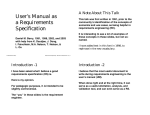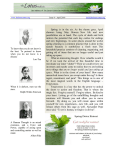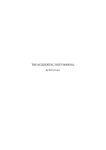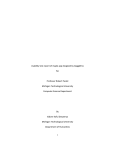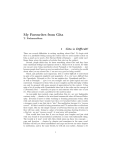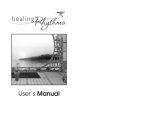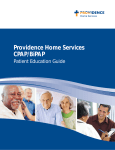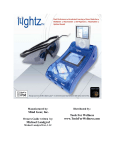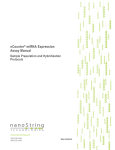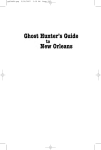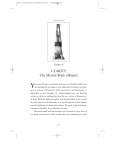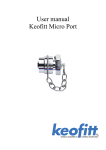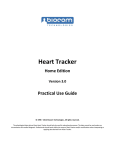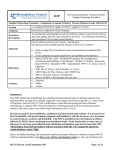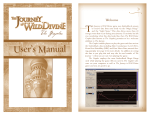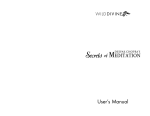Download Relaxing Rhythms 15 Step Guided Training Manual
Transcript
Relaxing Rhythms 15 Step Guided Training Manual RELAX RELIEVE RESTORE http://www.wilddivine.com/content/bc/relaxingrhythms-manual/page01.html[4/21/14, 6:20:54 PM] Relaxing Rhythms 15 Step Guided Training Manual We would like to express our deepest gratitude to each of the generous and compassionate authors, artists and medical advisors who helped us in the development of Relaxing Rhythms. Zen Master Nissim Amon Dean Ornish, M.D. Andrew Weil, M.D. Joan Borysenko Stephen Cope Nawang Khechog & Sharon Salzberg Their work comes directly from the heart and will provide you with hours of inspiration and motivation as you head down the path toward improved well-being and happiness in your life. And to our partner and friends at Sounds True, particularly Tami Simon and Nancy Smith, we could not have done this without you. Thank you. Published by The Wild Divine Project 9550 S Eastern Ave, Suite 253 Las Vegas, NV 89123 Copyright ©2014 The Wild Divine Project All rights reserved. http://www.wilddivine.com/content/bc/relaxingrhythms-manual/page02.html[4/21/14, 6:21:04 PM] Page 03: Table of Contents CONTENTS BEFORE YOU BEGIN 04 PART ONE: SELF DISCOVERY 11 STEP 1: Quiet the Mind 13 STEP 2: Observe Your Thoughts 17 STEP 3: Find your Inner Balance 21 STEP 4: Release Physical Tension 25 STEP 5: Cultivate Positive Emotions 29 STEP 6: Reveal Your Inner Wisdom 33 PART TWO: CREATING HAPPINESS 37 STEP 7: Subdue Your Inner Critic 39 STEP 8: Open Yourself to Others 43 STEP 9: Practice Compassion 47 STEP 10: Discover Gratitude 51 STEP 11: Connect With Something Outside of Yourself 55 PART THREE: DEVELOP LIFE SKILLS 60 STEP 12: Set Your Intentions 62 STEP 13: Take a Daily Supplement 66 STEP 14: Commit to a Personal Practice 70 STEP 15: Find Your Rhythm 74 TECHNICAL SUPPORT AND SAFETY REGULATIONS 78 INDEX: Active Feedback Events & Mind/Body Practices Listed by Self Exploration Category 83 Listed by Guided Training Step 86 http://www.wilddivine.com/content/bc/relaxingrhythms-manual/page03.html[4/21/14, 6:21:05 PM] Page 04: Before You Begin BEFORE YOU BEGIN You will wake Welcome to Relaxing Rhythms! You're about to embark on a very special journey, one up to your life that will take you deep inside the inner workings of your mind and body and give you in ways you never imagined the keys to a happier, healthier life. You will discover that happiness, after all, is not simply a by-product of luck, chance or good fortune, but a choice—your choice. The Active Feedback technology, expert guidance, beautiful visuals and soothing sounds in Relaxing Rhythms were all designed to help you uncover your natural ability to counter the effects of stressful feelings, relieve feelings of anxiety, and experience total self-transformation. Get ready to practice effective tools and techniques, gain valuable insights, build awareness to identify and change negative thought patterns, and learn to cultivate positive emotions—all with just a few minutes practice each day. You'll improve your mood, your energy level, and your ability to connect with the world around you. In short, you'll begin to wake up to your life in new and profound ways. http://www.wilddivine.com/content/bc/relaxingrhythms-manual/page04.html[4/21/14, 6:21:07 PM] Page 05: How to Use This Book HOW TO USE THIS BOOK We designed Relaxing Rhythms so that you could customize it to suit your own personal style of learning—we know that your way will be unique. This manual can serve as a navigation tool for you to get all you can from the program. There are many ways to use this manual: Read it through once to get the lay of the land, or keep it by your side as you launch head-first into the 15 steps included in the program. You can even read the chapters on their own again and again to find tips and tricks for taking on the challenges of personal development, building awareness, increasing relaxation, and finding inspiration. Take what works, leave what doesn't—what matters most is that you take from it that which enriches and expands your awareness, while deepening your sense of calm and peace. You'll be amazed at how simply tuning in to the body and its rhythms can bring about a significantly increased sense of your own well-being. You'll be amazed at how simply tuning in to the body and its rhythms can bring about a significantly increased sense of your own well-being http://www.wilddivine.com/content/bc/relaxingrhythms-manual/page05.html[4/21/14, 6:21:09 PM] Page 06: What is Mind/Body Wellness? WHAT IS MIND/BODY WELLNESS? The simple act The concept of mind/body wellness springs from the widely held belief that your mental, of being aware emotional, and spiritual self are not separate from the physical, flesh-and-blood you. They are all of your breath and energy level can have a considerable impact on deeply interconnected on levels you may not even be aware of yet. While we may more easily accept the idea that physical pain can have emotional repercussions, the reverse is also true: Emotional disturbances can, and most likely will, have an impact on our how you think, physical state. For example, have you ever ended up with a cold during a time of acute stress? feel, and act In this holistic philosophy, all components of the self are consideredit says that we are more than what we think, what we feel, or what happens to us physically—that the “self” is the sum of all of these components weaved together. How to achieve it The more attention and awareness you bring to what's going on inside and around you, the less likely you are to be driven by unconscious habits and thought patterns that may have a negative impact on your physical and mental health. One easy way to begin to cultivate this connection between mind and body is to bring yourself back to your physical self through breathwork and meditative relaxation. The simple act of being aware of your breath or energy level on a daily basis can have a considerable impact on how you think, feel, and act. In fact, with regular practice, you may find you are less susceptible to feelings of stress, fatigue, and illness. The lessons in this program will show you a range of different ways to strengthen your mind/body connection—and thus, your overall well-being. What is Meditation? The age-old practice of meditation is an integral part of many traditions, both religious and non-religious. While there are thousands of different ways to meditate, at the core of each is the practice of focusing and quieting the mind so that we can uncover and re-experience the eternal quiet and deep wisdom within each of us. In this day and age, our busy lives are filled with so much sound, movement, and activity that meditation is essential to help us go within, tune out the distractions, and reconnect with our authentic self. You don't need any special training, religious background, or prior knowledge of meditation to experience its benefits in your life. Everything you need to know you'll learn right here. Meditation is not as much Sometimes people who are new to meditation wonder if there's some secret or trick to it, or about doing it right but if they're doing it right. The goal is not to do it right, but to do it regularly—because it's about doing it regularly with consistency that the unlimited benefits of meditation are discovered. http://www.wilddivine.com/content/bc/relaxingrhythms-manual/page06.html[4/21/14, 6:21:11 PM] Page 06: What is Mind/Body Wellness? http://www.wilddivine.com/content/bc/relaxingrhythms-manual/page06.html[4/21/14, 6:21:11 PM] Page 07: What is Breathwork? WHAT IS BREATHWORK? Breathing is one It's been said that the breath is the link between the physical and spiritual. The simple of the most act of tuning in to your breath can have a profound effect on your mind and body; it important tools in meditation can alter your brainwaves, lower your blood pressure, and slow your heart rate. Breath is also a vital tool in meditation. Paying attention to the natural in-and-out flow of each breath gives your mind a place to return to and focus your awareness. In this program you will learn different breathing techniques to help you raise and lower your energy, relax your mind, release physical tension, and create a sense of calm. By engaging in even just a few minutes of conscious breathing, you help undo and even prevent the negative effects that stressful feelings can have on your health. If you leave this program only having learned how to use your breath to experience a few minutes of rich and utter quiet, you will have given yourself an invaluable gift to use for the rest of your life. http://www.wilddivine.com/content/bc/relaxingrhythms-manual/page07.html[4/21/14, 6:21:12 PM] Page 08: What is Active Feedback? WHAT IS ACTIVE FEEDBACK? Biofeedback technology uses sophisticated electronic equipment to measure and monitor changes in your internal physiological states. The measurements offer insight into what's going on energetically in your body, and provide a platform on which you can make positive changes to your mental, physical and emotional states. Though biofeedback is usually done in conjunction with a professional biofeedback therapist, Relaxing Rhythms was uniquely designed so that you could take advantage of our Active Feedback technology on your own. Many biofeedback therapists have endorsed Relaxing Rhythms because they believe it provides a powerful and effective way to experience first-hand the connection between your mind and body. They also believe the knowledge that stems from that experience can improve your overall sense of wellbeing and physical health. Relaxing Rhythms' Active Feedback technology allows you to witness the The Active Feedback in Relaxing Rhythms The Active Feedback hardware and finger sensors, when plugged into your computer, allow you to interact with the software. You will be able to witness the positive powerful effects that breathing and meditation can have on your mind effects of the practices taught in this program as they are mirrored back to you on and body as you the screen. For instance, in Step 1, you'll try an Active Feedback event called “The begin to let go of Breathing Tree”, in which you will be instructed to breathe deeply and slowly to relax your mind and body. You'll know that you are doing this successfully when the staircase begins to form onscreen, signaling to you that your energy is actually changing. http://www.wilddivine.com/content/bc/relaxingrhythms-manual/page08.html[4/21/14, 6:21:14 PM] stressful feelings Page 09: What Is Active Feedback? Relaxing Rhythms measures two critical components of your physiology: Skin Conductance Level (SCL) and Heart Rate Variability (HRV). SCL measures sweat gland activity through increased perspiration in your fingertips as it rises and falls with your physical and mental feelings of stress. HRV is a more complex measurement that indicates the variable time between heart beats. A resting HRV of 5-20 beats is healthy for anyone under 50. With some young athletes you may see HRV as high as 30-50. Relaxing Rhythms teaches you specific breathing techniques that will increase your HRV and research has shown that those who exhibit greater heart rate variability tend to live longer and healthier lives. By increasing your HRV, you can also improve brain and heart activity and boost your immune system, which helps you counter the negative effects of stress. When you tune in to your mind/body connection and experience positive emotions such as relaxation, patience, compassion, and joy, your body responds in kind, synchronizing its physical rhythms in a healthy way. But it doesn't stop there. Studies have also indicated that when you achieve a state of positive, balanced energy, those vibrations ripple outward from you into your environment, even affecting the brainwaves of anyone you touch—proving that positive energy states are contagious, contributing to the health and well-being of everyone around you! http://www.wilddivine.com/content/bc/relaxingrhythms-manual/page09.html[4/21/14, 6:21:15 PM] Page 10: As You Practice WHAT TO EXPECT This Active Feedback technology found in Relaxing Rhythms functions as a kind of As you practice mirror in which to view your inner workings—which can be very enlightening indeed. It and play, you can help sharpen your awareness of your emotional, mental, and spiritual states. This increased awareness will allow you to voluntarily shift your focus and attention, calm train your mind and body to react in a positive way, and center your mind, and learn new patterns for coping with everyday feelings of encouraging stress. healthy habits You may find some activities more challenging, while others will come very naturally to you—this is normal. As you learn to control your energy and state of mind, you may experience an internal shift—an “a-ha” experience where you'll just intuitively know how to do things. You'll develop a natural sense of when to breathe more slowly or deeply, or how to connect with a positive emotion. The more you practice and play, the more you train your mind and body to react in a positive way, encouraging your body to healthfully regulate itself. And remember, the most important tools you will take away from Relaxing Rhythms are not those that you practice while sitting at your computer, but those that you are able to take with you and use in your everyday life. It will take some practice, but who is more deserving of that time than you? http://www.wilddivine.com/content/bc/relaxingrhythms-manual/page10.html[4/21/14, 6:21:17 PM] Part One - Self Discovery PART ONE STEP 1: QUIET THE MIND 13 STEP 2: OBSERVE YOUR THOUGHTS 17 STEP 3: FIND YOUR INNER BALANCE 21 STEP 4: RELEASE PHYSICAL TENSION 25 STEP 5: CULTIVATE POSITIVE EMOTIONS 29 STEP 6: REVEAL YOUR INNER WISDOM 33 http://www.wilddivine.com/content/bc/relaxingrhythms-manual/page11.html[4/21/14, 6:21:26 PM] Part One - Self Discovery http://www.wilddivine.com/content/bc/relaxingrhythms-manual/page11.html[4/21/14, 6:21:26 PM] Page 12: Self Discovery SELF DISCOVERY Changing your life, even in small, incremental ways, can only happen effectively when you start with yourself. It's no different with happiness. After all, a happy life is not simply the result of luck, good fortune, or a personality trait. It's a decision you make to see yourself, others, and the world around you in a certain way. The first part of this program is devoted to self discovery. In the next six steps, you will turn your attention inward so that you can fine-tune your awareness of your mind and body, and in so doing, start to see yourself as separate from your thoughts, feelings, and habits. You'll begin to experience that deep quiet from which true happiness springs, flowering in moments of inspiration, elation, and happiness. The more you nurture yourself, the more capable you are of growing strong and coping with the stresses that threaten or test your well-being at every turn. At each phase of growth, you will reveal to yourself and the world a new, beautiful, dynamic part of you. http://www.wilddivine.com/content/bc/relaxingrhythms-manual/page12.html[4/21/14, 6:21:28 PM] Untitled Document snow slowly settles to the bottom, leaving the water crystal clear. Your mind functions in a similar way— every day, a series of events, interactions, worries, fears, and thoughts kick up a whirling chaos of internal activity, making it hard to really see what’s going on. By taking a few minutes every day to allow the mind to become quiet, and letting the hundreds of fragments of thoughts and distractions drift to the bottom, you can gain greater clarity into who you are—apart from your thoughts and fears. By taking a few minutes every day to allow the mind to become quiet, and letting the hundreds of fragments of thoughts and distractions drift to the bottom, you can gain greater clarity into who you are— apart from your thoughts and fears. Take a moment to notice your breath What you’ll learn In the following exercises you’ll learn to observe the breath and then allow it to become deeper and slower so that it can actually help you relax and become quiet.Though it may sound easy enough, don’t be surprised if you find it challenging. Our minds are designed to think, and so to sit in what is perceived to be an ‘idle’ position may be frustrating at first. Learning to just ‘be’ is MIND/BODY PRACTICES LEARNING TO QUIET THE MIND Inspiration: A message from Andrew Weil, M.D. Mind/Body Practice #1: Breathing, Relaxing Dean Ornish, M.D. leads you through this guided Introduction to Meditation as you learn how to begin your daily practice. Mind/Body Practice #2: Breathing, Relaxing Andrew Weil, M.D. teaches the Deeper, Slower Breath to quiet the mind and increase relaxation. http://www.wilddivine.com/content/bc/relaxingrhythms-manual/page13.html[4/21/14, 6:21:30 PM] Untitled Document STEP 1 something we’re not traditionally taught to do, and so, as with any skill, you have to learn how—and when you do, the rewards are tremendous. Learning meditation techniques to help expe- TRY THIS In the yogic tradition, the word for breath is prana—which also means spirit.Your breath is the vital link between mind, body, and spirit; the keystone for self-transformation; and a place you will return to again and again, throughout this program and, ideally, your life. The most powerful tool for quieting the mind is the breath. Take a moment now to notice yours. Is it short and shallow? Slow and deep? When you breathe, does your lower belly or your chest expand? Take a moment to enjoy a full, satisfying breath. Really feel the air moving in and out of your body. Breathing is the only bodily function that is at once wholly under your control and yet flows through you without effort. It has the ability to both calm and revive you. By learning to focus on your breath, you become more present in your body, and less susceptible to the harrowing effects of stress.Take your breathwork anywhere you wish—and practice often, whether it’s ten minutes in the morning or before bed, driving to work, or standing in line at the bank. Let your breath keep you calm. http://www.wilddivine.com/content/bc/relaxingrhythms-manual/page14.html[4/21/14, 6:21:32 PM] Page 15: Quiet the Mind STEP 1 Learning meditation techniques to Your breath is help experience an inner sense of the vital link peace and well-being can help you between mind, return to your natural state, one body, and spirit of joy. If an awareness and appreciation for your breath is the only thing you take away from this step, you have gained a valuable tool in and of itself. TRY THIS In the yogic tradition, the word for breath is prana—which also means spirit.Your breath is the vital link between mind, body, and spirit; the keystone for self-transformation; and a place you will return to again and again, throughout this program and, ideally, your life. The most powerful tool for quieting the mind is the breath. Take a moment now to notice yours. Is it short and shallow? Slow and deep? When you breathe, does your lower belly or your chest expand? Take a moment to enjoy a full, satisfying breath. Really feel the air moving in and out of your body. Breathing is the only bodily function that is at once wholly under your control and yet flows through you without effort. It has the ability to both calm and revive you. By learning to focus on your breath, you become more present in your body, and less susceptible to the harrowing effects of stressful feelings. Take your breathwork anywhere you wish—and practice often, whether it's ten minutes in the morning or before bed, driving to work, or standing in line at the bank. Let your breath keep you calm. http://www.wilddivine.com/content/bc/relaxingrhythms-manual/page15.html[4/21/14, 6:21:34 PM] Quiet the Mind Practice Event: Breathing Tree ACTIVE FEEDBACK EVENT: BREATHING TREE Allow your breath to fall in sync with the rhythm of the tree as it moves with the wind, blowing gently back and forth—in for a count of five and out for five. This is called the Heart Breath. Continue breathing slowly and deeply until the staircase takes shape before your eyes. This breathing technique has a calming and centering effect on the body. After your practice Take a moment now to notice how your breath feels. Do you sense a difference? What about your mood? Is your mind quieter? Has there been a shift in your mental or physical state? What did you find most challenging about this exercise? http://www.wilddivine.com/content/bc/relaxingrhythms-manual/page16.html[4/21/14, 6:21:37 PM] Page 17: Observe Your Thoughts STEP 2 OBSERVE YOUR THOUGHTS INSPIRATION : A MESSAGE FROM DEAN ORNISH, M.D. Notice your Once you've begun to learn how to quiet your mind, the next step involves watching how your mind thoughts—and works, independently of you. This might sound odd—after all, how do you observe something that observe them essentially does all the observing? Learn to detach from your thoughts Yogis have long known the benefits of detaching from the ceaseless stream of thoughts, fears, and worries that form in our heads, in order to just be. Just as your lungs produce carbon dioxide, your mind produces thoughts--it has for as long as you can remember and will continue to do so for as long as you live. However, the more you can learn to observe those thoughts, the less you will react to them--and thus can begin to dramatically decrease feelings of stress. http://www.wilddivine.com/content/bc/relaxingrhythms-manual/page17.html[4/21/14, 6:21:38 PM] Page 18: Observe Your Thoughts Is what you think who you are? Very often, we use what we think (our opinions, preferences, and so on) as a way of establishing or defining our identity. But is what you think who you are? What you'll learn Practice observing Think about the number of times your thoughts took a turn, and, regardless of the reality of the situation, you went along for the ride, getting so worked up that you couldn't concentrate on the task at hand. How often have you harped on a negative thought or memory, only to get more hurt or angry? We all have. MIND/BODY PRACTICES LEARNING TO OBSERVE YOUR THOUGHTS Inspiration: A message from Dean Ornish, M.D. Mind/Body Practice #1: Mindfulness, Breathing Practice this Peaceful Breath with Nawang Khechog as you learn to become more aware of your thoughts and less reactive to them. Mind/Body Practice #2: Mindfulness, Breathing Learn to Follow Your Breath with Andrew Weil, M.D. as you practice the skill of observing your thoughts and create a greater sense of well-being. http://www.wilddivine.com/content/bc/relaxingrhythms-manual/page18.html[4/21/14, 6:21:44 PM] thoughts as they arise, rather than getting attached to them Page 19: Observe Your Thoughts STEP 2 In the following exercises, you will learn to focus your attention by following your breath and Start to watch observing thoughts as they pass through, like clouds. Little by little, the clouds will clear, revealing the clear sky of your mind, and resulting in not only a sense of peace, but clarity. Cherish these how your mind works clear spaces between thoughts—therein lies the key to happiness. TRY THIS The key to mastering the mind is learning to, as the Buddhists say, "surf on the waves of your thought,"—a happy alternative to letting yourself get tossed and pummeled by them on the shore. You can do this by observing your thoughts as they come and go, watching rather than reacting. Your thoughts, like waves, will arise naturally— but now you have the tools to ride them smoothly. For the next few days, notice when your thoughts start racing and feelings of stress begin to escalate —and take that opportunity to stop and observe this process. What are those thoughts about? Where are they coming from? What's causing them? The more you can detach from spiraling thoughts, the less likely you are to become victimized by them. http://www.wilddivine.com/content/bc/relaxingrhythms-manual/page19.html[4/21/14, 6:21:47 PM] Observe Your Thoughts Practice Event: Floating Balloons ACTIVE FEEDBACK EVENT: FLOATING BALLOONS Watch how your thoughts and energy affect the flight of the balloon. When you focus on uplifting or stimulating energy, the balloon follows suit and rises, and it sinks as you bring your energy down. Use this simple exercise to observe your own patterns of thought and feeling, and note how the balloons respond to your inner atmosphere. Try letting go of the balloons so that they dance on the breeze of your thoughts, mirroring your breath. After your practice You've just finished another vital step toward achieving peace of mind and well-being. Did you find it difficult to do? Were you able to control the direction of the balloons? How do you feel now? What kinds of thoughts did you observe—were they the same ones over and over, or different? Your thoughts will do whatever it takes to get your attention, which is why this exercise can be a challenge. http://www.wilddivine.com/content/bc/relaxingrhythms-manual/page20.html[4/21/14, 6:21:50 PM] Page 21: Find Your Inner Balance STEP 3 FIND YOUR INNER BALANCE INSPIRATION : A MESSAGE FROM DEAN ORNISH, M.D. When you quiet It's natural to be drawn to your thoughts and to follow them—and a real skill and discipline to resist your mind, you can them. Now, of course, the goal is not to resist every thought you ever have! Your thoughts are not take your mental "temperature" and steady your energy, regardless of what thoughts unhealthy in and of themselves, but wouldn't it be nice to let the negative ones roll by? When you can take on an active role observing your thoughts, rather than a passive one, you will notice a difference in the way you react to them and to the world around you. arise Now you're going to take this skill a step further by not just observing your thoughts, but working to actively maintain your energy levels as you do so. http://www.wilddivine.com/content/bc/relaxingrhythms-manual/page21.html[4/21/14, 6:21:52 PM] Page 22: Find Your Inner Balance Your thoughts affect your mood Your thoughts create a reaction in you that affects your energy level. For instance, you may have a thought that triggers a negative reaction, and soon, you're seething and upset—and you're only washing dishes! Our thoughts transport us from this world into another, so that we can end up causing more stress and unhappiness in our lives by living in the world of those thoughts, rather than grounded in the present. By becoming What you'll learn more aware of This lesson is one of inner balance—how to find and maintain that balance, even when thoughts your energy, you're and feelings threaten to throw you off kilter. First, take note of your energy level right now—are better able to stay you feeling alert and awake? Maybe a little tired or edgy? When you quiet your mind, you can take your mental "temperature" and steady your energy, regardless of what thoughts arise. We call this "cultivating awareness" because it requires practice and intention. MIND/BODY PRACTICES LEARNING TO FIND YOUR INNER BALANCE Inspiration: A message from Dean Ornish, M.D. Mind/Body Practice #1: Balance, Breathing A breathing meditation with Dean Ornish, M.D. to reclaim and restore your Natural State of Balance. Mind/Body Practice #2: Balance, Relaxation Practice this meditation with Zen Master Nissim Amon as you try to identify your perfect state of Inner Balance. http://www.wilddivine.com/content/bc/relaxingrhythms-manual/page22.html[4/21/14, 6:21:54 PM] balanced throughout your day, and less likely to overreact Page 23: Find Your Inner Balance STEP 3 The way this benefits you in your own life is clear: By becoming more aware of your energy, you're better able to stay balanced throughout your day, and less likely to react (or overreact) to sources of stress at work or at home. One way to do this is to create a beautiful, peaceful place in your mind that you can return to again and again. In the following practices, you'll learn to create balance and calm through visualization. TRY THIS Take your energy temperature throughout the day. Try it when you first wake up, a few minutes at your desk, or standing in line at the grocery store. Become aware of whether your energy is Your thoughts have an effect on your energy level spiking or dropping, and then use your breath to help level that energy. A few minutes of slow, rhythmic breathing can work in both cases—it calms the nervous system while replenishing your body with oxygen, which can help make you feel more alert. Learning to maintain your energy can help reduce the extreme ups and downs which cause wear and tear on your nervous system. http://www.wilddivine.com/content/bc/relaxingrhythms-manual/page23.html[4/21/14, 6:21:57 PM] Find Your Inner Balance Practice Event: Rock Garden ACTIVE FEEDBACK EVENT: STACK THE ROCKS Take a moment to become aware of your own energy level before you begin. Once you click on the candle, the computer takes a reading of your body's rhythms, and will measure your success by how level you remain throughout this challenge. The rocks will begin to float out from the left side of your screen and start to stack one atop the other. Don't try to move or control the rocks; if you do, the rocks will resist and either float up off screen or drop prematurely. The lesson here is one of stillness and balance. Observe and remain detached, and the rocks will automatically stack up as they're supposed to. If they don't, it's a sign that you're getting in your own way. After your practice Practicing detachment can help you respond differently to stressful events, and keep you from making purely snap judgments or emotion-based decisions. Remaining balanced and detached does not mean you're aloof, disconnected, or emotionally cold; rather, it means you can receive the information without bias or judgment. In this state you will be able to make better, clearer decisions. http://www.wilddivine.com/content/bc/relaxingrhythms-manual/page24.html[4/21/14, 6:21:59 PM] Page 25: Release Physical Tension STEP 4 RELEASE PHYSICAL TENSION INSPIRATION : A MESSAGE FROM NAWANG KHECHOG The mind and How would you describe the way you feel right now? body are not Fatigued? Stressed? Calm? Focused? Would the way separate entities living a parallel existence, but intimately linked. you describe your current state be one that represents what you're "feeling" in your head or what you sense in your body? We tend to spend much, if not most, of our time in our heads— particularly in the world we live in, where a large part of our work and social interactions are done facing a computer screen. Sometimes it's easy to forget you have a body altogether! Until…You get hungry. You get a headache. You have to use the bathroom. It's as if, once those basic humans are met, the body is, for the most part, dismissed. And in fact, the things you do to meet those needs (eat a snack, take an aspirin, empty your bladder) are done in an effort to silence the body's needs so that you can get back to what you were doing before that. http://www.wilddivine.com/content/bc/relaxingrhythms-manual/page25.html[4/21/14, 6:22:01 PM] Page 26: Release Physical Tension You are more than your mind Your mind may be the key to happiness, but you are not simply a mind; you are a body, too—a body with its own unique needs and desires; sensations and energy; wisdom and intelligence. Mindful exercise It's a complex, fascinating thing that needs far more than simple benefits both watering and feeding to keep it happy and healthy. And to deny the body and mind rich physical experience of our bodies is to miss out on one of the greatest things about being alive. What you'll learn In the first three steps of this program, you learned the importance of quieting the mind and clearing it of mental clutter by focusing on the breath. In this one, you're going to become more fully present in the moment by focusing on your body. The idea (and growing science) behind mind/body wellness is based on the idea that the mind and body are not separate entities living a parallel existence, but intimately linked, and that how you treat one deeply affects the other. You'll learn to identify places in your body where you hold tension. After all, stress is not simply an experience of the mind; it's very much a physical experience as well. MIND/BODY PRACTICES LEARNING TO FIND YOUR INNER BALANCE Inspiration: A message from Nawang Khechog Mind/Body Practice #1: Relaxation, Balance Create a state of deep relaxation as Nawang Khechog takes you through this guided meditation, I Want to be Relaxed. Mind/Body Practice #2: Relaxation, Mindfulness, Balance Learn to find and release physical tension as Stephen Cope guides you through a Daily Body Scan. http://www.wilddivine.com/content/bc/relaxingrhythms-manual/page26.html[4/21/14, 6:22:04 PM] Page 27: Release Physical Tension STEP 4 Stress can register in your body as a physical injury might. Research suggests that a high percentage of illnesses are stress-induced. If your stress goes unaddressed, your body takes the hit and the result can be anything from mild aches and pains to inflammation and disease. Releasing tension doesn't happen all at once—it's a gradual process. It took a long time for your body to accumulate those layers of tension and stressful feelings. To strip them away, you must be gentle with yourself, and patient. The more aware you are of physical tension, the more able you are to let it go. Activities that engage mind and body benefit both—you'll not only feel more relaxed with regular physical activity, but you may also find you're mentally sharper and more alert—and more prepared to face the day's challenges head-on. TRY THIS Make it a point to stay connected to your physical self. One way to do this is to do a body scan, in which you mentally scan your body from head to toe for tension and then breathe into those places to release that tension. Another way is to find opportunities throughout the day to engage in mindful movement—this is critical to keeping stress and its negative physical effects at bay. Think about ways you can do that, whether it's doing some gentle stretching when you wake up, or taking a brisk walk in the morning or afternoon. Maybe you can walk to the post office rather than drive, or spend an hour walking with a friend instead of sitting in a coffee shop. http://www.wilddivine.com/content/bc/relaxingrhythms-manual/page27.html[4/21/14, 6:22:06 PM] Release Physical Tension Practice Event: Yoga Passage ACTIVE FEEDBACK EVENT: YOGA PASSAGE In this exercise you will open the gates to the temple by releasing all tension from your body. Slow your breathing, aiming for three to five counts on the inhale and the exhale, gradually lengthening them until you can count to seven on the inhale and seven on the exhale. Imagine any tension releasing out of the bottoms of your feet. As you relax, the arms of the purple figure will begin to part. It's important not to try too hard to get the doors to open--the harder you try, the more they will elude your efforts, and the arms will shut. Once you have attained a consistent state of true relaxation, the arms will open completely, the golden orb will fall to the center, and the doors will open. After your practice What do you notice about how your body feels now, as opposed to when you started the exercise? What patterns of tension have emerged? Could you let tension go? How can you create a regular practice of addressing physical tension to keep it from building up again? The time spent using and focusing on your body and your breath, often called mindful exercise, benefits not just the body but the mind, too—and you can do it any time. It should feel good to practice. The relaxed state is a natural one—we just forget how to experience it. http://www.wilddivine.com/content/bc/relaxingrhythms-manual/page28.html[4/21/14, 6:22:09 PM] Page 29: Cultivate Positive Emotions STEP 5 CULTIVATE POSITIVE EMOTIONS INSPIRATION : A MESSAGE FROM NAWANG KHECHOG Counter the effects Now that you've done the important work of quieting the mind, balancing your energy of negative thoughts level, and becoming aware of the connection between your mind and body, you're by cultivating positive emotions ready to begin putting these skills to work to help you effectively cope with the variety of situations you face every day. Countering negative thoughts Unless you work in the kind of job that puts you on the front lines of real physical danger every day, chances are you are relatively "safe" in your office, your home, or school—but still the stress of interactions, work, and business politics can elicit a damaging negative reaction. An insensitive word from a coworker, a fight with your partner, or whisperings of a layoff may not cause physical harm, but they set off a spiral of negative thoughts that can take their toll on your mind and body. http://www.wilddivine.com/content/bc/relaxingrhythms-manual/page29.html[4/21/14, 6:22:10 PM] Page 30: Cultivate Positive Emotions You can counter the effects of these negative thoughts by cultivating positive emotions. This doesn't mean simply thinking happy thoughts. This practice can help keep you from falling victim to negative emotions or events that challenge you on a daily basis. MIND/BODY PRACTICES LEARNING TO CULTIVATE POSITIVE EMOTIONS Inspiration: A message from Nawang Khechog Mind/Body Practice #1: Breathing, Balance Zen Master Nissim Amon leads this calming breath meditation to help you learn to Handle Your Emotions. Mind/Body Practice #2: Balance, Mindfulness Transform Your Emotions as you practice this important meditation from Nawang Khechog to support a healthier mind and body. http://www.wilddivine.com/content/bc/relaxingrhythms-manual/page30.html[4/21/14, 6:22:13 PM] Page 31: Cultivate Positive Emotions STEP 5 What you'll learn To cultivate positive emotions, you will draw on your creativity and imagination to cope with negative emotion. By giving these positive “counter” emotions shape and form, you give them “handles” so you can easily pick them up when you need them. Emotions and qualities like patience, optimism, or energy can be slippery and hard to get a hold of. By associating them with something we can feel, see, and experience directly, we make them more accessible in our lives. The more time you spend focusing on these positive emotions or qualities, the more real they become. TRY THIS Cultivate patience. Often we are only aware of patience when we're running very low on it. But have you ever thought about what patience looks like to you? Think about patience in a way that you may not have before—give it shape and form. What color is it? What shape? Maybe you see it as an object, like a tea kettle or a rock, or maybe something more abstract, like an undulating wave or a gentle rain. It doesn't matter what you choose—the important thing is that it becomes real to you in a way that it hasn't been before. The next time you find yourself getting frustrated, for instance, rather than compound an already foul mood, turn your attention to the form for patience you crafted during meditation. Admire its fine details; feel the essence of this mental object positively affecting your mood. Try it with any emotion you wish to access more readily. Slip into the silky robe of centeredness, sip from the tea of compassion, or carry a sparkling outlook wherever you go. By making positive qualities real to you, you can change the way you cope with feelings of stress and live your life. http://www.wilddivine.com/content/bc/relaxingrhythms-manual/page31.html[4/21/14, 6:22:15 PM] Cultivate Positive Emotions Practice Event: Juggling Balls ACTIVE FEEDBACK EVENT: JUGGLING BALLS Lift the balls in the air by amplifying your energy. You can do this by taking deep, energizing breaths, laughing out loud, shouting, or even just imagining a time when you were excited and happy. The balls will respond by flying upward. What you learn is the incredible power you have to control your mood and your energy, just by changing your thought pattern—and how your thoughts and feelings really do create your reality. After you've practiced keeping the balls up, see if you can lower them back down by relaxing— breathe deeply and slowly, and think calming thoughts. Once the balls are back on the ground, you've completed the event. After your practice Now that you have learned a new approach to using positive thought and emotion to combat the tendency to develop negative patterns, you have a skill that you can use and develop throughout your life. You have, in a sense, begun the process of creating your own toolbox for coping, one that you have access to at all times. The more productive and positive approaches you take for meeting feelings of stress and negativity head on, the more in control of your life you will feel. http://www.wilddivine.com/content/bc/relaxingrhythms-manual/page32.html[4/21/14, 6:22:17 PM] Page 33: Reveal Your Inner Wisdom STEP 6 REVEAL YOUR INNER WISDOM INSPIRATION : A MESSAGE FROM ZEN MASTER NISSIM AMON View the place This is the last step in the Self Discovery segment of the program. Now you can draw between your on the five skills you've learned so far: quieting the mind, observing your thoughts, thoughts as one of lightness and clarity—the place in which the mind finding balance, releasing physical tension, and cultivating positive emotions. You've watched your mind at work, and in so doing increased your self-awareness. reveals itself What is inner wisdom? Call it intuition, an inner intelligence, or perhaps a connection to the Divine. However you choose to define it, it's in the practice of meditation, this quieting of the mind and detaching from your thoughts that you allow your inner guidance to become uninhibited. When you get the mental clutter out of the way, you may find you can actually "see" yourself—and your life, relationships, and decisions— more clearly. http://www.wilddivine.com/content/bc/relaxingrhythms-manual/page33.html[4/21/14, 6:22:19 PM] Page 34: Reveal Your Inner Wisdom When you bathe in this awareness, you begin to heal the fissures and cracks made by aggravated feelings of stress, and can emerge with a sense of peace and purpose. What you'll learn In this step, you are going to allow yourself to experience even more deeply those quiet moments between thoughts, that fulfilling yet empty space of pure being. Rather than an empty "void," try to xperience this as a place of lightness and clarity—the place in which the mind reveals itself. Bathe in awareness and emerge with a sense of peace and purpose You'll learn how to assist the process by practicing a meditation that combines visualization and vibration as a way to infuse your entire body with a warm and healing energy. MIND/BODY PRACTICES LEARNING TO REVEAL YOUR INNER WISDOM Inspiration: A message from Zen Master Nissim Amon Mind/Body Practice #1: Mindfulness, Balance Practice this important meditation on Loving Kindness with Sharon Salzberg as you begin to cultivate mindfulness. Mind/Body Practice #2:Mindfulness, Balance Enjoy this new state of being as Nawang Khechog guides you through The Practice of Mindfulness in this thoughtful meditation. http://www.wilddivine.com/content/bc/relaxingrhythms-manual/page34.html[4/21/14, 6:22:25 PM] Page 35: Reveal Your Inner Wisdom STEP 6 As you can see, self discovery happens Ironically, it's our gradually, and only with intent, persistence, and very struggle for gentleness. Ironically, it's our very struggle for control and security that wears us out in the end. control and security that wears us out in the end Happiness is not in that struggle, but in learning the tools which allow it to surface naturally. What you've done in these six steps is begin to awaken your mind and body to their true potential, not by doing, fixing, or controlling, but by quieting, observing, and releasing. You are now ready to move into Part Two in which you will explore your connection to the world around you and put these skills to greater use. TRY THIS Take note of the occasional hunch. While meditation can help clear your mind and create the ideal environment for your inner wisdom to surface, you don't have to be in the middle of meditation for this to happen. Try keeping an intuition journal—just a small notebook to collect the insights or emotions that occur to you during meditation or throughout the day. This might mean that vaguely bad feeling you have about something a coworker said to you recently, or that excited sense telling you to move forward with a big decision. The more you pay attention to those inner "nudges," the more real they become—and the more you allow them to lead you. http://www.wilddivine.com/content/bc/relaxingrhythms-manual/page35.html[4/21/14, 6:22:28 PM] Reveal Your Inner Wisdom Practice Event: Drifting Feather ACTIVE FEEDBACK EVENT: DRIFTING FEATHER In this activity, you'll get to practice letting go of thoughts and emotions as you allow yourself to drift slowly and gently like the feather. The feather represents your state of mind; as you become more relaxed, the feather floats lower and lower. Like the feather, let the distracting thoughts in your mind float by. Breathe slowly and deeply as the feather drops all the way down. Be patient—while you can ramp up energy rather quickly, coming down takes time. Focus on the process here, not the end result. After your practice Congratulations! You've completed Part One: Self Discovery, and have begun to cultivate awareness, positive emotions, and a sense of peace. http://www.wilddivine.com/content/bc/relaxingrhythms-manual/page36.html[4/21/14, 6:22:30 PM] Part Two - Creating Happiness PART TWO STEP 7: SUBDUE YOUR INNER CRITIC 39 STEP 8: OPEN YOURSELF TO OTHERS 43 STEP 9: PRACTICE COMPASSION 47 STEP 10: DISCOVER GRATITUDE 51 STEP 11: CONNECT WITH SOMETHING OUTSIDE OF YOURSELF 55 http://www.wilddivine.com/content/bc/relaxingrhythms-manual/page37.html[4/21/14, 6:22:39 PM] Part Two - Creating Happiness http://www.wilddivine.com/content/bc/relaxingrhythms-manual/page37.html[4/21/14, 6:22:39 PM] Part Two: Creating Happiness CREATING HAPPINESS Ask ten happy people what makes them happy, and you will probably get ten different responses. That's because happy lives are as uniquely diverse as the people who live them. However, dig below the specifics and you will see that people who are truly happy share some similar qualities: They are in control of their life and their decisions, but flexible enough to accommodate whatever comes their way. They live in the moment and enjoy the gift of the here and now—but are sustained by dreams, hopes, and a special breed of optimism that survives the problems of the day. In the following five steps, you'll take another leap toward creating personal happiness by cultivating what are often overlooked and underdeveloped qualities (particularly by those who are bitterly unhappy in their lives), namely, empathy, compassion, and gratitude. These are not intended as codes of etiquette or behavior, but as rich and rewarding skills in and of themselves—and essential to happiness. Whereas meditation can help you focus on and connect with your own natural state of being, it can also connect you to infinite sources of energy and love that can sustain you through the life's ups and downs. Let's begin! http://www.wilddivine.com/content/bc/relaxingrhythms-manual/page38.html[4/21/14, 6:22:41 PM] Page 39: Subdue Your Inner Critic STEP 7 SUBDUE YOUR INNER CRITIC Self-criticisms Have you ever noticed how often you criticize yourself? For many of us, it's a kind of accumulate, knee-jerk reaction: “I shouldn't have done that (or eaten that, or said that)” or “Why layer by layer can't I be more like him or her?” These little put-downs may not seem like much, but they can add up and negatively affect your self-confidence. Developing self-compassion Small self-criticisms accumulate, layer by layer, like sand, until they swallow you whole. Sometimes we make it worse by criticizing our self-criticism! This negative self-talk can be destructive to you and your relationships. If you've ever spent a lot of time with someone who has no compassion for him or herself, then you know how tiring it can be. http://www.wilddivine.com/content/bc/relaxingrhythms-manual/page39.html[4/21/14, 6:22:42 PM] Page 40: Subdue Your Inner Critic The way to begin to let go of self-criticism is to move in the opposite direction—toward compassion. After all, if you are able to practice the art of compassion for yourself, you will be that much more capable of sharing it with others. What You'll Learn So rather than take aim at the inner critic, your goal in this exercise will be to again acknowledge, detach, and observe that critic-while practicing love and kindness toward yourself. Turn the spotlight on the critic for a change, rather than letting it cast shadows of doubt across all that you say or do. MIND/BODY PRACTICES LEARNING TO SUBDUE YOUR INNER CRITIC Inspiration: A message from Dean Ornish, M.D. Mind/Body Practice #1: Breathing, Energy Learn to identify and enjoy your own Natural Beauty in this guided visualization with Zen Master Nissim Amon Mind/Body Practice #2: Balance, Mindfulness Train yourself on The Art of Forgiveness of both self and others in this important healing meditation with Nawang Khechog http://www.wilddivine.com/content/bc/relaxingrhythms-manual/page40.html[4/21/14, 6:22:45 PM] Page 41: Subdue Your Inner Critic STEP 7 Acknowledge, detach and The inner critic likes to whisper over your shoulder or from behind the curtain, but observe your inner critic and when you expose it for what it is and counter its criticism with love and compassion, change those judgments with love its powers are quickly foiled. You'll soon find that it ceases to be as toxic or potent, and begins to lose hold on your psyche. The result is a more confident, decisive you. TRY THIS The next time you catch yourself engaging in selfcriticism, stop yourself, take a step back, and ask yourself why you're doing it.What's the situation, what's at stake, and why are you blaming yourself? Think about if the same thing happened to a friend and she came to you upset and blaming herself. What would you tell her? This will allow you to gain some perspective and start treating yourself with the same kindness and compassion with which you'd treat someone else you love and care about. http://www.wilddivine.com/content/bc/relaxingrhythms-manual/page41.html[4/21/14, 6:22:47 PM] Subdue Your Inner Critic Practice Event: The Pear Tree ACTIVE FEEDBACK EVENT: THE PEAR TREE In this exercise, you will practice your ability to quiet your inner critic, not with force, but with patience and compassion. Lure a new friend into view by maintaining a calm, peaceful state of mind, just as you would if trying to gently coax a shy child or animal out of hiding. Notice that if you become impatient, or start to feel anxious, your visitor will retreat into hiding. When you have reached a steady state of relaxation and balance, you'll be able to share a pear from the tree with your gentle friend. After your practice It isn't easy, is it? Old habits die hard, and self-chastising is one that's probably been with you for quite a while. But no one ever became a stronger, better person by allowing themselves to be taken to task by their habitual self-judgment. Rather, allow those thoughts or words to roll off you and then down the drain, like so much water. http://www.wilddivine.com/content/bc/relaxingrhythms-manual/page42.html[4/21/14, 6:22:50 PM] Page 43: Open Yourself to Others STEP 8 OPEN YOURSELF TO OTHERS One of the most It's easy to take our view of the world for granted.What we see, and how we respond to it, constitutes powerful things you our experience. But everything is not as we first perceive it. One of the most powerful things you can do can do is change is to step back and adjust the way you view the world around you. This is how you begin to cultivate the way you see the empathy, a critical tool for achieving happiness— not by focusing on how life should adhere to your world around you desires, but by letting go of those things and opening yourself up to a wider, more generous perspective. How empathy contributes to a happier YOU The practice of empathy is a natural progression from what you started doing in this program: detaching from your thoughts, opinions, and judgments in order to observe from another perspective. http://www.wilddivine.com/content/bc/relaxingrhythms-manual/page43.html[4/21/14, 6:22:52 PM] Page 44: Open Yourself to Others STEP 8 The practice of empathy involves applying this skill to the complexity of relationships. After all, when do relationships, MIND/BODY PRACTICES personal or professional, tend to sour? When we get overly involved with or attached to our own perspective, our own judgments, putting our own views ahead of someone else's. What you'll learn Learning to Open Yourself to Others Inspiration: A message from Zen Master Nissim Amon By opening up your worldview to accommodate another experience, you remove your personal "blinders" and expand your Mind/Body Practice #1: Balance, Mindfulness perspective. This in turn leads to more productive and rewarding Open your heart and mind to others with this relationships with the people in your life. Contemplative Thought meditation with Nawang Khechog. Mind/Body Practice #2: Balance, Mindfulness Practice The Force of Kindness meditation with Sharon Salzberg as you integrate this shift in your perspective and open your world to others. http://www.wilddivine.com/content/bc/relaxingrhythms-manual/page44.html[4/21/14, 6:22:55 PM] Page 45: Open Yourself to Others STEP 8 You'll also learn how empathy changes your relationship to the world around you, and how rather than seeing yourself in the world, you recognize that the world is within you. TRY THIS Think for a moment about a challenging situation you've encountered recently. Maybe you had an uncomfortable exchange with a coworker or family member. What were the circumstances? What was said? How did your actions affect the situation? How did it end? Now, go back through the same event, this time coming at it from the other person's perspective. What might have triggered their words or actions? How do you perceive your own behavior—does it cast your own actions in a different light? Can you see what might have made that person act the way he did? You will find that when you make a regular practice of putting yourself in other people's shoes, you enrich your own experience and can be more flexible, more open-minded, more understanding, and of course, more compassionate. And in that fertile soil, happiness blooms. http://www.wilddivine.com/content/bc/relaxingrhythms-manual/page45.html[4/21/14, 6:22:58 PM] Open Yourself to Others Practice Event: Water Pagodas ACTIVE FEEDBACK EVENT: WATER PAGODAS The Heart Breath is a wonderful tool for calming the mind and opening the heart—something you need to do to practice empathy. Use the gentle motion of the boat on the water to guide your breath—inhale for five counts as the boat floats up, and exhale for five as it floats back down. Imagine that you are breathing with your heart; feel the breath flowing into and out of your heart center. When your breath falls in sync with its healing rhythm, the lights of the pagodas will burst into a beautiful display. After your practice Like any skill, empathy takes practice. It's not something that will happen magically. It's also important to remember that empathy is a positive and healing personal emotion, and should not be confused with sympathy. Sympathy is a sharing of feelings, generally of sadness or loss. Empathy is the understanding of those feelings and should elevate you and inspire dignity, rather than pity. http://www.wilddivine.com/content/bc/relaxingrhythms-manual/page46.html[4/21/14, 6:23:00 PM] Page 47: Practice Compassion STEP 9 PRACTICE COMPASSION INSPIRATION : A MESSAGE FROM NAWANG KHECHOG Empathy is a skill; You just learned about the power of empathy to change the way you see the world— compassion is the and yourself. But you can't have empathy without experiencing compassion. Part of manner in which we perform it creating inner happiness is making a regular practice of feeling, showing, and acting out of compassion. Cultivating a compassionate attitude Compassion is defined as a "deep awareness of another's suffering coupled with the wish to relieve it." At the very core of our humanity is shared experience. If you know what it's like to be hurt, then you can imagine the pain of another. Similarly, if you block out your own hurt, you may be quicker to block out others' as well. And we don't need to ask what kind of a world it would be if there was no compassion at all. http://www.wilddivine.com/content/bc/relaxingrhythms-manual/page47.html[4/21/14, 6:23:01 PM] Page 48: Practice Compassion We see enough of that on the nightly news already. Whereas empathy is a skill, compassion is the manner in MIND/BODY PRACTICES which we perform it—the attitude with which we approach all that we think, see, and do. Sure, there are some days when you feel irritable, tired, or downright mean. But the true challenge is resisting the urge to lash out despite the way you feel. This is where practicing compassion comes in. What you'll learn Part of creating inner happiness involves making a regular LEARNING TO PRACTICE COMPASSION Inspiration: A message from Nawang Khechog Mind/Body Practice #1: Breathing, Relaxation, Learn the Heart Breath with Nawang Khechog, one of the most important mind/body practices for opening the heart and building a happy mind and healthy body. practice of feeling, showing, and acting out of compassion. This doesn't mean going about your days Mind/Body Practice #2: Breathing, Relaxation, Mindfulness with a weeping heart or making an elaborate show of your Practice this deep and personal meditation with Dean compassion. Ornish, M.D. as you learn The Freedom of Compassion. Compassion can help you rise above feelings of stress, and can be a source of strength and confidence http://www.wilddivine.com/content/bc/relaxingrhythms-manual/page48.html[4/21/14, 6:23:09 PM] Page 48: Practice Compassion http://www.wilddivine.com/content/bc/relaxingrhythms-manual/page48.html[4/21/14, 6:23:09 PM] Page 49: Practice Compassion STEP 8 Genuine compassion does not call undue attention to itself; it simply infuses you with a loving awareness of others. You'll fine-tune your compassion by becoming more aware of it in you and in your life. You'll also learn how the transformative power of love and compassion can change the quality of your life and health. TRY THIS It's easy to be compassionate when you're having a good day, but what about when you're faced with a situation that tests your patience? The next time you feel your fuse burning dangerously short, imagine turning on your compassion like a faucet and let it flow—even if it contradicts what you'd normally do or say. Even if this feels uncomfortable or out of character, try it a few times and note how the situation turns out—did it go differently than you expected? How were your actions or words received? Rather than think of it as something you do for others, think of it as something you do for yourself. Compassion grows anywhere you plant it and bears fruit in the driest soil. And the more you put into the world, the more of it there will be. http://www.wilddivine.com/content/bc/relaxingrhythms-manual/page49.html[4/21/14, 6:23:12 PM] Practice Compassion Practice Event: Ivory Harp ACTIVE FEEDBACK EVENT: IVORY HARP In this activity, you will use the Heart Breath (follow the butterfly for cadence) to tune the ivory harp. Let your breath fall into an easy, even rhythm. Your energy becomes like a tuning fork, and the harp begins to use it to tune itself. Listen as your energy is translated into music and you can hear yourself relaxing. Your personal practice mimics this exercise in many ways—it's not something you turn "on" or "off," but an ongoing fine-tuning of your energy and skill. By creating a regular practice, you take the cacophony that is life and feelings of stress, and channeling your energy to turn it into music. After your practice You've just taken the first steps toward identifying and understanding the power of compassion and its connection with your own happiness. Developing a compassionate attitude is like learning to play a musical instrument—the more you practice, the more natural it becomes. And you'll find it actually changes you. See for yourself how hard it is to experience true compassion and still be caught up in an energy-sapping melodrama. Compassion can be an antidote to feelings of stress simply because it draws you out of yourself. http://www.wilddivine.com/content/bc/relaxingrhythms-manual/page50.html[4/21/14, 6:23:15 PM] Page 51: Discover Gratitude STEP 10 DISCOVER GRATITUDE INSPIRATION : A MESSAGE FROM ZEN MASTER NISSIM AMON We say "thanks" many times throughout the day.You may say it automatically when a Gratitude opens cashier hands you your change or when someone holds the door for you. But how up your way of often do you really allow yourself to truly experience that gratitude? Gratitude goes far beyond common courtesy—it's not just something you offer for the other person's thinking and can elevate your mood sake. In fact, this rich, shimmering quality has the power to affect your emotions and change the way you feel. The truth about gratitude Gratitude uplifts and opens up your way of thinking. It can restore a sense of appreciation and optimism, energize your spirit, and renew your perspective. When you take the time to really feel gratitude, even for the challenges you face in life, your outlook can shift, and even help you find solutions. http://www.wilddivine.com/content/bc/relaxingrhythms-manual/page51.html[4/21/14, 6:23:16 PM] Page 52: Discover Gratitude In many religious traditions, gratitude is expressed through a blessing-of a person, an event, a marriage, an object. But you don't need to subscribe to any particular belief system to experience or to offer one. In the act of "blessing," you simply become aware of the gift before you, whatever it is, and appreciate its presence and value, wishing that the best comes of it. That's it. You acknowledge the good stuff, rather than focus on the bad stuff—something Gratitude has a we could all do more of. cleansing effect on MIND/BODY PRACTICES LEARNING TO DISCOVER GRATITUDE Inspiration: A message from Zen Master Nissim Amon Mind/Body Practice #1: Mindfulness, Energy Follow Joan Borysenko on this guided meditation and learn to experience Gratitude Everyday, even in the quietest, most unexpected moments. Mind/Body Practice #2: Energy, Mindfulness Practice this uplifting force with Zen Master Nissim Amon, as you Open Your Heart with gratitude in this soothing meditation. http://www.wilddivine.com/content/bc/relaxingrhythms-manual/page52.html[4/21/14, 6:23:22 PM] the mind and spirit Page 53: Discover Gratitude STEP 10 What you'll learn Discover the powerful effect gratitude can have on your mood and outlook. Tuning in to that sense of gratitude alone will bring more joy, peace, and passion into your life. A heartcentered meditation will help you experience the healing energy of your own heart where gratitude resides. TRY THIS Go for a gratitude walk. Drop what you're doing for 15 minutes and, if you can, go outside and start walking. The rule is that during your walk, you are not allowed to think about work or replay scenarios (real or imagined) in your head. First, focus only on the sensation of your feet hitting the ground, your legs stretching and your hips opening up, your breathing getting deeper and more relaxed. Then turn your attention to all of the things in your life that you are happy about—whether it's a loving relationship, a nice home, or a satisfying career. Now let those more obvious things give way to the more subtle things that you might never have thought about, but that also contribute joy to your life, that infuse you with pure gratitude. At the end of these 15 minutes (or longer if you like), return to what you were doing and notice your energy. Has it changed? How do you feel now? http://www.wilddivine.com/content/bc/relaxingrhythms-manual/page53.html[4/21/14, 6:23:24 PM] Discover Gratitude Practice Event: Bowl of Joy ACTIVE FEEDBACK EVENT: BOWL OF JOY This activity gives you firsthand experience of the elevating power of gratitude. To get the bowl of joy to levitate, you must raise your energy. Laugh, shout, cheer-and fill your heart with a sense of overwhelming gratitude. Think of the things that make you smile and laugh- a funny situation at work, something your child said recently, or imagine a scene that brings you great joy. As you do, the bowl will begin to lift higher and higher, as if riding on the sheer power of your gratitude. After your practice Now that you've had some practice rediscovering the power of gratitude and tuning in to your heart vibrations, you can turn to it whenever you like. It's nearly impossible to experience gratitude while simultaneously feeling miserly and mean. Which is why the regular practice of gratitude, you'll find, is one of the quickest and most enduring methods for creating happiness in your life. http://www.wilddivine.com/content/bc/relaxingrhythms-manual/page54.html[4/21/14, 6:23:27 PM] Page 55: Connect with Something Outside of Yourself STEP 11 CONNECT WITH SOMETHING OUTSIDE OF YOURSELF INSPIRATION: A MESSAGE FROM ZEN MASTER NISSIM AMON Energy goes by many names. In traditional Chinese medicine, it's called qi (pronounced "CHEE"). In We already the yogic tradition, it's prana, or life force. In Native American cultures, it's spirit. Energy is the have all the essence of who you are, not something you "use up" like so much gasoline. While there's a big energy we need market for products purported to "give" you more energy, ancient cultures teach us that we already have all the energy we need— it's just a matter of letting it flow through us. http://www.wilddivine.com/content/bc/relaxingrhythms-manual/page55.html[4/21/14, 6:23:28 PM] Page 56: Connect with Something Outside of Yourself STEP 11 The truth about energy We can learn something from these ancient traditions—namely, that we can channel energy and thus, we never run out of it. What we end up doing is allowing our bodies and minds to fall out of balance, and feelings of stress to accumulate, disrupting the natural flow of energy. In this sense, energy is akin to electricity. We can never run out of energy; Like qi, it's unseen, an invisible force that makes things happen—lights go on, computers power up, music plays. It brings “life” to objects, just as qi, prana, or spirit animates us. we can only block its flow And, as with electricity, if we do not “plug in” to a greater source than ourselves, (whether you experience it in nature, or call it God, the Divine, or the universe), we quickly lose steam. MIND/BODY PRACTICES LEARNING TO CONNECT WITH SOMETHING OUTSIDE OF YOURSELF Inspiration: A message from Zen Master Nissim Amon Mind/Body Practice #1: Breathing, Relaxation Connect to the Universe and to a greater source of energy outside of yourself with this inspiring meditation by Zen Master Nissim Amon Mind/Body Practice #2: Breathing, Relaxation Experience this greater life force physically and mentally as you Let Yourself be Breathed with Andrew Weil, M.D. http://www.wilddivine.com/content/bc/relaxingrhythms-manual/page56.html[4/21/14, 6:23:32 PM] Page 57: Connect with Something Outside of Yourself STEP 11 What you'll learn We do not Like an object that takes its source from an electrical socket, we do not create energy, but channel it from a greater source. In this step, you'll learn how to connect with a greater source of life and energy outside of yourself through meditation. After all, you're not a finite being—you are larger than the body that contains you. In a sense, you not only have create energy, but channel it from a greater source access to an infinite supply of energy—you are energy. We practice meditation not to shut out the world or escape ourselves but to become more present to it. This awareness happens gradually. You may notice small shifts in your attitude; you may experience moments of this connectedness, an experience beyond words to describe it. As much as the idea of being “at one with the universe” has been used so often it may seem cliché, the essence of it remains true. http://www.wilddivine.com/content/bc/relaxingrhythms-manual/page57.html[4/21/14, 6:23:33 PM] Page 58: Connect with Something Outside of Yourself STEP 11 TRY THIS Tonight, remove yourself from the hustle and bustle of your normal routine for just for a few moments. Take a walk or drive to a favorite place and let yourself settle into the vastness of the world around you. For you, this might be watching the sun set over the ocean, in the mountains looking up at the stars, walking down a favorite tree-lined street, or just looking out your window to expand your view. Allow yourself to reflect upon both your exquisite uniqueness and at the same time your undeniable relationship to all those around you. Fill yourself with the energy that runs through us all and allow yourself to feel whole. http://www.wilddivine.com/content/bc/relaxingrhythms-manual/page58.html[4/21/14, 6:23:36 PM] Connect with Something Outside of Yourself Practice Event: Blue Planet ACTIVE FEEDBACK EVENT: BLUE PLANET In this activity, you will practice the Heart Breath (five counts in, five counts out--match your breath to the sparkle of light as it rises and falls). As you breathe, fill your lungs not just with oxygen but with compassion and love. Then, direct that energy outward with each exhale. As your heart comes into coherence, you'll begin to shower the earth with a light rain that can help to nurture both you and the world around you. Use this practice as a vehicle for feeling connected to everything around you. After your practice Congratulations on completing Part Two: Creating Happiness! You've just taken a big step toward reconencting with your own personal power source by quieting and focusing the mind, tuning your awareness, and opening, rather than closing, those channels of energy. This in turn is what will replenish your own energy and sustain your spirit in the long term. http://www.wilddivine.com/content/bc/relaxingrhythms-manual/page59.html[4/21/14, 6:23:38 PM] Part Three: Develop Life Skills PART THREE STEP 12: SET YOUR INTENTIONS 62 STEP 13: TAKE A DAILY SUPPLEMENT 66 STEP 14: COMMIT TO A PERSONAL PRACTICE 70 STEP 15: FIND YOUR RHYTHM 74 http://www.wilddivine.com/content/bc/relaxingrhythms-manual/page60.html[4/21/14, 6:23:47 PM] Part Three: Develop Life Skills http://www.wilddivine.com/content/bc/relaxingrhythms-manual/page60.html[4/21/14, 6:23:47 PM] Part Three: Develop Life Skills DEVELOP LIFE SKILLS Congratulations on completing the first two parts of the program! You've begun to explore your potential in many important ways. You've expanded your perspective while learning to focus; honed your powers of observation while taking an active role in your personal development; and cultivated positive emotions while connecting with the world around you. But this program is just a starting point—you have the rest of your life to live, and you want to live it as richly as you can. Learning to make good and regular use of these practices is not unlike deciding to stick to an exercise program. You have to find one that works for you specifically and that you enjoy. It may mean meditating for a few minutes every morning, or carving out time each night for experiencing gratitude. The key to your success is doing your personal practices regularly and with intention—that's where the real transformation occurs. In this last section, you'll learn to set your intentions and transform negative emotions. You'll discover ways to create your own personal practice and find your rhythm so that you can continue the great work you've begun. When you do, happiness won't be some faraway destination, but a part of your every day. http://www.wilddivine.com/content/bc/relaxingrhythms-manual/page61.html[4/21/14, 6:23:49 PM] Page 62: Set Your Intentions STEP 12 SET YOUR INTENTIONS INSPIRATION: A MESSAGE FROM ZEN MASTER NISSIM AMON Since you're on the home stretch of this program, it's a good time to look back at the ground you've covered and decide what is most valuable to you. What did you enjoy most? What made you feel the most alive? What was the biggest challenge? Setting your The beauty of this journey is that it doesn't take you to one place where all happy people reside— intention is vital rather, it helps get you to where you want to go. Now that you have the tools, you decide what you to keeping you on track want to build with it, and what you most want your life to be. An intention keeps you on track Your intention unites your thoughts and actions so that what you think and do is infused with meaning and purpose. http://www.wilddivine.com/content/bc/relaxingrhythms-manual/page62.html[4/21/14, 6:23:51 PM] Page 63: Set Your Intentions SET YOUR INTENTIONS It takes awareness to another level, so that you are not just conscious of your actions but fully behind them. If you want to eat with intention rather than rush through your lunch as usual, this requires being present to your meal, engaged in the process of chewing and tasting, and deriving satisfaction from your food. Your intention keeps you connected to the moment. Your intention doesn't limit, but MIND/BODY PRACTICES LEARNING TO SET YOUR INTENTIONS Inspiration: A message from Zen Master Nissim Amon Mind/Body Practice #1: Mindfulness, Balance Begin your day by setting Clear Intentions for yourself as Joan Borysenko guides you through this vital daily practice. Mind/Body Practice #2: Balance, Mindfulness Set your course for Conscious Living each day in this meditation with Nawang Khechog. http://www.wilddivine.com/content/bc/relaxingrhythms-manual/page63.html[4/21/14, 6:23:54 PM] guides, inspires, and motivates you Page 64: Set Your Intentions STEP 12 What you'll learn Your intention keeps You're going to begin to identify, define, and set your intentions. They grow and change with you —but without a clear intention, it's as if you're going on a journey with no map and no you connected with the moment destination: You may take a nice walk, but you can't be sure you'll get anywhere. By setting real intentions for yourself, you inspire your path toward a happier, more fulfilling life. Allow your intentions to evolve and change with you, to come alive in all that you do. Keep in mind that an intention amounts to nothing unless you commit to acting in ways that support it. TRY THIS Start with this simple practice. Before you get out of bed in the morning, take five minutes to set your intention for the day. Close your eyes, take a deep breath, and envision the day you want to have. If you have an important meeting, see yourself presenting with confidence. If you have a date, anticipate and welcome the romance of the evening. You may choose to see yourself sending out and receiving positive energy from all the people with whom you interact. Maybe you simply see yourself moving through your day calmly, without anxiety or worry. Setting a clear intention this way can have powerful effects on the outcome of your daily activity. http://www.wilddivine.com/content/bc/relaxingrhythms-manual/page64.html[4/21/14, 6:23:57 PM] Set Your Intentions Practice Event: Golden Horn STEP 12 ACTIVE FEEDBACK EVENT: GOLDEN HORN In this exercise, you set your intention on your breath to get the horn to sound and the flower to grow. This focused use of breath will help clear your mind of distractions. Use the Heart Breath—in for five counts, and out for five, matching your breath to the rise and fall of the floating seeds. When you establish a rhythm with your breath, the horn will sound and a petal will appear on the flower. Continue for seven breaths to complete the cycle and fill in the rest of the petals. After your practice Once you've spent some time allowing yourself to become focused and relaxed, you will be more open to your intentions, and you can begin the process of making them happen through positive action. This is how our intentions become a reality. But also remember that it's natural for them to evolve and change with you; this keeps them dynamic and alive. http://www.wilddivine.com/content/bc/relaxingrhythms-manual/page65.html[4/21/14, 6:23:59 PM] Page 66: Take a Daily Supplement STEP 13 TAKE A DAILY SUPPLEMENT INSPIRATION: A MESSAGE FROM DEAN ORNISH M.D. A daily "supplement" There is growing evidence to support that nutritional supplements go a long way to promote sustains and overall health. Of course, you can't live on supplements alone—by definition, supplements are supports your greater intention designed to be part of a healthy, balanced lifestyle. They help fill in the nutritional cracks and support the systems of your body so that you're in a better position to fight off illness. If we do this for our bodies, why not do it for our minds and spirit as well? Your daily dose By fortifying your spirit with a daily "dose" of healthy affirmation, you can release negative emotions, replace them with positive ones, and fortify yourself against the effects of stress, anger, and resentment. http://www.wilddivine.com/content/bc/relaxingrhythms-manual/page66.html[4/21/14, 6:24:00 PM] Page 67: Take a Daily Supplement Spending just a few minutes acknowledging the positive forces at work in your life can help weaken the grip of your fears or insecurities and help you sustain your greater intention—whether it's to live a more peaceful life or simply a healthier one. And while you wouldn't take a vitamin once a month and expect it to work wonders for your health, a few positive thoughts now and again can't be expected to undo the layers of tension that accumulate every day. The key is daily loving care. Replace negative thoughts with positive ones MIND/BODY PRACTICES LEARNING TO TAKE A DAILY SUPPLEMENT Inspiration: A message from Dean Ornish M.D. Mind/Body Practice #1: Balance, Mindfulness Learn to Ride the Wave of your emotions and build greater inner wellness with this guided practice from Stephen Cope. Mind/Body Practice #2: Balance, Mindfulness A daily guided visualization practice with Stephen Cope to Clear the Field of emotions and begin each day with a clean and fresh beginning. http://www.wilddivine.com/content/bc/relaxingrhythms-manual/page67.html[4/21/14, 6:24:04 PM] Page 68: Take a Daily Supplement STEP 13 What you'll learn You have the power to communicate positive, sustaining messages to yourself that promote your personal growth and development, as well as a sense of peace and centeredness. You'll learn to transform habitual or negative emotions into those that heal and support you, and clear the slate so that you can start each day fresh. TRY THIS What can you do to care for yourself daily in a positive, loving way? If your intention is to create more peace in your day, for instance, maybe one way of doing that is by avoiding office politics and gossip, which do more harm to you than good. Rather than tell yourself "I will not participate in any gossip ever!", your daily dose might be something like, "If I find myself beginning to complain or whisper about someone else, I will find one positive thing to say about that person instead." Just a simple substitution, trading a bitter pill for a sweeter option. http://www.wilddivine.com/content/bc/relaxingrhythms-manual/page68.html[4/21/14, 6:24:07 PM] Take a Daily Supplement Practice Event: Lotus Blossoms ACTIVE FEEDBACK EVENT: LOTUS BLOSSOMS In the following activity, you will find yourself in a soothing courtyard setting by a pool. Use the Heart Breath to calm and center your mind and body (follow the butterfly to set your breathing rhythm). As you become calm and relaxed, swallows will appear and swoop down to drop lotus petals on the surface of the pool. Think of these gifts from the birds as offerings you can give yourself every day. After your practice In this step, you learned that the power of your personal practice hinges not only on your larger intention but on your ability to care for yourself. The result, you'll find, is that you can actually reprogram your psyche and let go of the worries that plague you. When you build up more and more of a resistance to spiritual "viruses" that attack your sense of peace and self esteem, you're less likely to be thrown off balance by them. When taken regularly, these daily doses go a long way to keeping you strong and balanced, and ready for whatever the day brings. http://www.wilddivine.com/content/bc/relaxingrhythms-manual/page69.html[4/21/14, 6:24:09 PM] Page 70: Commit to a Personal Practice STEP 14 COMMIT TO A PERSONAL PRACTICE INSPIRATION: A MESSAGE FROM ZEN MASTER NISSIM AMON But how? you might ask. How do I make this happen on my own? The key is to keep your There is no one right way to personal practice simple—and consistent. create or perform a personal practice There are lots of ways to start building your own practice. You can try beginning your day with an energizing breath, nip stressful feelings in the bud with a quick meditation, or practice scanning your body for tension every night before bed. There is no one right way to create or perform a personal practice. It depends on what you find most effective, most enjoyable, and most suited to your needs. Be gentle with yourself Most importantly, as you develop a practice that works for you, be patient and loving to yourself. The idea is not to whip yourself into shape or enforce a stringent daily regimen, but to grow and experiment with a practice that serves you. Remember, it's called “practice” for a reason. Don't put demands on your personal development that overwhelm you. You have nothing to prove to anyone (including yourself), nor do you have anyone else's rules to follow. http://www.wilddivine.com/content/bc/relaxingrhythms-manual/page70.html[4/21/14, 6:24:11 PM] Page 71: Commit to a Personal Practice What you'll learn Breathing exercises are simple to do on your own and can be the most effective tools for balancing energy. You'll learn two basic exercises that you can incorporate into your daily practice: one for stimulating and energizing, and one for calming and centering. You'll also gain some practice in maintaining your focus, which is often the first thing to go when we begin to feel stressed. By learning to become more focused in our thoughts and actions, we're not only more productive, but we can stave off the stressful experience of feeling scattered and overwhelmed. MIND/BODY PRACTICES LEARNING TO COMMIT TO A DAILY PRACTICE Inspiration: A message from Zen Master Nissim Amon Mind/Body Practice #1: Breathing, Energy A great way to begin your daily routine and increase your energy with Andrew Weil, M.D.'s Stimulating Breath. Mind/Body Practice #2: Breathing, Relaxation The perfect end to your daily routine with Andrew Weil, M.D.'s Relaxing Breath practice. http://www.wilddivine.com/content/bc/relaxingrhythms-manual/page71.html[4/21/14, 6:24:13 PM] Page 72: Commit to a Personal Practice STEP 14 TRY THIS Select one focus for your practice to stick with all week--this can be a word you meditate on or a quality you cultivate during your moments of quiet, such as compassion, patience, kindness, gratitude, or peace (or any other that appeals to you). Combine your creativity and self-discipline to make your personal program one that brings about a better, calmer, more grounded you. http://www.wilddivine.com/content/bc/relaxingrhythms-manual/page72.html[4/21/14, 6:24:17 PM] Commit to a Personal Practice Practice Event: Bow and Arrow ACTIVE FEEDBACK EVENT: BOW AND ARROW In this activity, you'll use your breath in a dynamic way to help relax, energize, and focus in order to hit the target with your arrow. As you draw back the bow, raise your energy to lift your aim; relax to lower it. Once you are aligned with the target, let the arrow go. Setting a daily practice requires the same kind of attention and patience as shooting an arrow. This exercise teaches you not only to be aware of your energy, but also to create a desired outcome through focus. Likewise, staying centered and focusing on your intention (your personal target) helps you hit your mark, every time. After your practice Above all else, keep your practice simple and sacred—these few minutes you devote to your self care and personal growth are critical to your well-being. Another great way to integrate your practice is to stay connected to your energy. The deep awareness you've cultivated will help you notice when tensions are mounting in your mind and body. By returning your attention to your breath, you can relax the mind, release tension in your muscles, slow your heart rate, and ground your energy.. http://www.wilddivine.com/content/bc/relaxingrhythms-manual/page73.html[4/21/14, 6:24:19 PM] Page 74: Find Your Rhythm STEP 15 FIND YOUR RHYTHM INSPIRATION: A MESSAGE FROM ZEN MASTER NISSIM AMON Check in with yourself A big part of this program has been about fine-tuning your awareness, in a sense, switching it on like a periodically, lamp so that you can see, notice, and observe. Now, you can't be expected to be fully aware of every particularly during times when you notice tension rising or your single thought, idea, event, and interaction every second of the day—that's not mindfulness, that's surveillance! The goal is to tune in to your natural rhythms, patterns, and tendencies so that you can maintain your energy and resist the downward spiral of stressful feelings and fatigue. focus waning http://www.wilddivine.com/content/bc/relaxingrhythms-manual/page74.html[4/21/14, 6:24:21 PM] Page 75: Find Your Rhythm Feeling for your rhythm Finding your own rhythm means that you check in with yourself periodically, particularly during times when you notice tension rising or your focus waning. This way, you resist getting swept up in old habits and are better able to address imbalances. When a situation arises, ask yourself "Who am I angry at and why?" or "What's really upsetting me right now?" and be prepared to listen to the honest answer. Then, get up, stretch, or simply close your eyes and take a few deep breaths, allowing yourself to experience that tension and then let it go. MIND/BODY PRACTICES LEARNING TO FIND YOUR RHYTHM Inspiration: A message from Zen Master Nissim Amon Mind/Body Practice #1: Balance, Mindfulness A guided meditation to help you feel and hold onto your true Inner Happiness with Nawang Khechog. Mind/Body Practice #2: Breathing, Balance, Mindfulness Nawang Khechog guides you through the final Wisdom Breath, to help set your rhythm for the day and for your life. http://www.wilddivine.com/content/bc/relaxingrhythms-manual/page75.html[4/21/14, 6:24:24 PM] The goal is to tune in to your natural rhythms, patterns, and tendencies Page 76: Find Your Rhythm" STEP 15 What you'll learn In this final step of the program, you'll learn how to understand—not master or control—your own unique rhythms. Living in harmony with them, and with yourself, is where happiness resides. You'll discover how to use your breath to tune in to those internal rhythms, how to manage the ebbs and flows of your life and practice, and how to let go and be gentle with yourself. TRY THIS Track your own rhythms. For one week, keep a notebook and check in with yourself three times a day (or more if you like). Keep those check-in times consistent so that you get a good reading. Are you groggy every morning? How do you feel at the end of most days? By tracking your own natural rhythms over the course of a week or more, you can begin to map your own highs and lows, and then match your practice to those needs. For instance, if you find you get wound up and distracted in the middle of your day, try taking a ten minute walk and focusing on your breath. If you can't relax at night, experiment with one of the breathing exercises you've learned to release tension and unwind. This way, you can create a practice that suits your individual needs. http://www.wilddivine.com/content/bc/relaxingrhythms-manual/page76.html[4/21/14, 6:24:28 PM] Find Your Rhythm Practice Event: Gentle Rain ACTIVE FEEDBACK EVENT: GENTLE RAIN In this activity, you will apply what you've learned in a calming meditation. Begin by taking deep, slow, even breaths. Once you've achieved a steady and relaxed state, the rain will begin to fall, at first lightly, then more heavily, filling the bowl with rain. This will help you tune in to nature's rhythms, which have a naturally calming effect, and you will emerge feeling refreshed and centered. After your practice Congratulations! You've completed the final lesson of the program. Now that you know what to do, becoming familiar with your rhythm will help you maintain self-discipline to guide your practice with a firm but gentle hand. Be consistent—and above all, kind. Forgive the imbalances, forgive the emotions, and in fact, be gentler with yourself on those occasions than on any other. Your emotions and reactions, while not always desirable, do play a role—to call your attention to things that aren't working in your life. If you view them as flags, not flaws, you are better able to use them to regain balance and peace. The idea here is not to keep score but to keep watch and to gently adjust for the imbalances as they come, and be there to catch yourself whenever you fall. http://www.wilddivine.com/content/bc/relaxingrhythms-manual/page77.html[4/21/14, 6:24:30 PM] Page 78: Technical Support and Information TECHNICAL SUPPORT & SAFETY INFORMATION Technical Support The answers to Frequently Asked Questions (FAQs) can be found in the User's Guide on page 25 or for a more detailed and updated list, visit www.wilddivine.com. Technical support is available by phone at 1-866-594-WILD (9453) from 8:30am–5pm PST Monday–Friday. You can also e-mail your question to [email protected] and expect a response within one business day. For customers in USA: Model Number: RR v12.5 Trade Name:Wild Divine Responsible Party: Wild Divine, Inc. Address: PO Box 61072 Suite 253, Boulder City, NV 89123 Telephone: 866 594 9453 http://www.wilddivine.com/content/bc/relaxingrhythms-manual/page78.html[4/21/14, 6:24:31 PM] Page 79: Technical Support and Information TECHNICAL SUPPORT Tested to comply with FCC Standards. FOR HOME OR OFFICE USE This device complies with the limits for a Class B digital device pursuant to Part 18 of the FCC rules. Operation is subject to the following two conditions: 1.This device may not cause harmful interference. 2. This device must accept any interference received, including interference that may cause undesired operation. For customers in Canada: This Class B digital apparatus meets all requirements of the Canadian Interference-Causing Equipment Regulations. For customers in Europe: The CE mark indicates that this product complies with the European requirements for safety, health, environment and customer protection. For more information on CE compliance, please refer to the enclosed Declaration of Conformity. This product has been determined to be lead-free and have no more than trace amounts of lead, cadmium, chromium IV, mercury, and PBD/PBDEs; substances associated with environmental risks. It certifies this product to be in compliance with European Union Directive 2002/95/EC. http://www.wilddivine.com/content/bc/relaxingrhythms-manual/page79.html[4/21/14, 6:24:33 PM] Page 80: Technical Support and Information Technical Description of Device The Active Feedback hardware is a multi-media, user interface device that contains an electronic Active Feedback component. This product consistsof three hardware components: the user applied finger sensors, unit, and a USB connector that plugs into your PC/Mac. Please refer to page 6 of the User's Manual for a full description of hardware set-up and usage. The 's Active Feedback component measures a player's Skin Conductance Level (SCL) and Heart Rate Variability (HRV) by taking pulse and measuring sweat gland activity at the finger sensors. This information is then relayed to the computer via the USB to be used by the Relaxing Rhythms software. The program provides numerous ways to visually represent feedback for greater awareness of these emotional and mental states. For a full description of goals and intentions of using Relaxing Rhythms' for Active Feedback practice please refer to pages 19-21 of the User's Manual as well as this Training Manual. Definitions: Type BF Equipment: This device is a type B equipment with an F-type isolated (floating) applied part. The applied part (user connected finger sensors) is isolated from all other parts of the equipment to the degree that leakage current will not exceed allowable limits given in IEC 60601.1, the International Standards for Medical Electrical Equipment. This device contains no user replaceable parts. For warranty and replacement information see page 39 of the User's Manual. Direct Current: This device is powered by 5 volts direct current as supplied by the PC USB cable. http://www.wilddivine.com/content/bc/relaxingrhythms-manual/page80.html[4/21/14, 6:24:35 PM] Page 81: Technical Support and Information Intended Use For a full description of goals and intentions of using your Relaxing Rhythms' for Active Feedback practice and recreational use please refer to pages 19-21 of the User's Manual as well as this Training Manual. Instructions for Use for the and Accessories: Please refer to this Training Manual for complete instructions for use. Additional instructions on hardware set-up and troubleshooting are available in Sections II-V of the Users Manual. General Product Guidelines Storage Procedures: • Do not store this product in extremely hot or cold places. • Store this product within the temperature range: -40°C to 70°C. • Store this product with a relative humidity range: 10–100% • Do not store this product in places with excessive dirt and dust, or in direct sunlight. Operating Precautions: • Use only with a computer that meets leakage current requirements as put forth by IEC 60601.1 • Use this product within the temperature range of 5°C to 35°C. • Use this product within a relative humidity range: 10–95% http://www.wilddivine.com/content/bc/relaxingrhythms-manual/page81.html[4/21/14, 6:24:37 PM] Page 82: Technical Support and Information Cleaning Procedures • Use a soft dry cloth to clean this product. • Disinfect sensors with alcohol or germicide. US Connector Cable • Do not touch the • terminal ends of the US hen unplugging the US Sensor Cable andling recautions connector. Doing so may cause failure of the device and or computer. connector, pull it out by the plug, not by the cable. andling recautions • hen unplugging the sensor cable, press down on the button on the plug and pull it out by the plug, not by the cable. he device meets isolation and leakage currents of IEC 60601.1. In order to maintain medical compliance, this device must be used with a C ac that meets IEC 60601.1. http://www.wilddivine.com/content/bc/relaxingrhythms-manual/page82.html[4/21/14, 6:24:39 PM] Page 83: Index INDEX Active Feedback Events & Mind/Body Practices Listed by SELF EXPLORATION Category Balance ACTIVE FEEDBACK EVENTS Step 3: Stack the Rocks . . . . . . . . . . . 24 Step 4: Yoga Passage . . . . . . . . . . . . . 28 Step 5: Juggling Balls . . . . . . . . . . . . . 32 Step 6: Floating Feather . . . . . . . . . . 36 Step 7: The Pear Tree . . . . . . . . . . . . 42 Step 8: Water Pagodas . . . . . . . . . . . 46 Step 9: Ivory Harp . . . . . . . . . . . . . . 50 Step 12: Golden Horn . . . . . . . . . . . 65 Step 13: Lotus Blossoms . . . . . . . . . 69 Step 15: Gentle Rain . . . . . . . . . . . . 77 MIND/BODY PRACTICES Natural State of Balance with Dean Ornish, M.D. . . . . . . . . . . . 22 Inner Balance with Zen Master Nissim Amon . . . . . . . . . . . . . . . . 22 I Want to be Relaxed with Nawang Khechog . . . . . . . . . . . . . 26 Daily Body Scan with Stephen Cope . . . . . . . . . . . . . . . . . . . . 26 Handle Your Emotions with Zen Master Nissim Amon . . . . . . . . . 30 Transform Your Emotions with Nawang Khechog . . . . . . . . . . . 30 Loving Kindness with Sharon Salzberg. . . . . . . . . . . . . . . . . . 34 The Practice of Mindfulness with Nawang Khechog . . . . . . . . . 34 The Art of Forgiveness with Nawang Khechog . . . . . . . . . . . . .40 Contemplative Thought with Nawang Khechog . . . . . . . . . . . .44 The Force of Kindness with Sharon Salzberg. . . . . . . . . . . . . 44 Clear Intentions with Joan Borysenko . . . . . . . . . . . . . . . . . . .63 Conscious Living with Nawang Khechog . . . . . . . . . . . . . . . . .63 Ride the Wave with Stephen Cope . . . . . . . . . . . . . . . . . . . . 67 Clear the Field with Stephen Cope . . . . . . . . . . . . . . . . . . . . . 67 http://www.wilddivine.com/content/bc/relaxingrhythms-manual/page83.html[4/21/14, 6:24:40 PM] Page 84: Index INDEX Active Feedback Events & Mind/Body Practices Listed by SELF EXPLORATION Category Breathing ACTIVE FEEDBACK EVENTS Step 1: Breathing Tree . . . . . . . . . . . 16 Step 2: Floating Balloons . . . . . . . . . 20 Step 3: Stack the Rocks . . . . . . . . . . 24 Step 5: Juggling Balls . . . . . . . . . . . . . 32 Step 7: The Pear Tree . . . . . . . . . . . . 42 Step 9: Ivory Harp . . . . . . . . . . . . . . 50 Step 11: Blue Planet . . . . . . . . . . . . . 59 Step 14: Bow and Arrow . . . . . . . . . 73 Step 15: Gentle Rain . . . . . . . . . . . . 77 MIND/BODY PRACTICES Introduction to Meditation with Dean Ornish, M.D. . . . . . . . . . 14 Deeper, Slower Breath with Andrew Weil, M.D. . . . . . . . . . . 14 Peaceful Breath with Nawang Khechog . . . . . . . . . . . . . . . . 18 Follow Your Breath with Andrew Weil, M.D.. . . . . . . . . . . . . . 18 Natural State of Balance with Dean Ornish, M.D. . . . . . . . . . 22 Handle Your Emotions with Zen Master Nissim Amon . . . . . . . 30 Natural Beauty with Zen Master Nissim Amon . . . . . . . . . . . . . . 40 Heart Breath with Nawang Khechog . . . . . . . . . . . . . . . . . . 48 Let Yourself be Breathed with Andrew Weil, M.D.. . . . . . . . . . 56 Stimulating Breath with Andrew Weil, M.D.. . . . . . . . . . . . . . 71 Relaxing Breath with Andrew Weil, M.D.. . . . . . . . . . . . . . . . . 71 Wisdom Breath with Nawang Khechog . . . . . . . . . . . . . . . . . . 75 http://www.wilddivine.com/content/bc/relaxingrhythms-manual/page84.html[4/21/14, 6:24:42 PM] Page 85: Index INDEX Active Feedback Events & Mind/Body Practices Listed by SELF EXPLORATION Category Energy ACTIVE FEEDBACK EVENTS MIND/BODY PRACTICES Step 7: The Pear Tree . . . . . . . . . . . . 42 Natural Beauty with Zen Master Nissim Amon . . . . . . . . . . . 40 Step 10: Bowl of Joy. . . . . . . . . . . . . 54 Gratitude Everyday with Joan Borysenko . . . . . . . . . . . . 52 Step 14: Bow and Arrow . . . . . . . . . 73 Open Your Heart with Zen Master Nissim Amon . . . . . . . . . 52 Stimulating Breath with Andrew Weil, M.D.. . . . . . . . . . . . 71 Mindfulness ACTIVE FEEDBACK EVENTS MIND/BODY PRACTICES Step 2: Floating Balloons . . . . . . . . . . . 20 Peaceful Breath with Nawang Khechog . . . . . . . . . 18 Step 4: Yoga Passage . . . . . . . . . . . . . 28 Follow Your Breath with Andrew Weil, M.D.. . . . . . . . . . 18 Step 5: Juggling Balls . . . . . . . . . . . . . 32 Daily Body Scan with Stephen Cope . . . . . . . . . . . . . 26 Step 6: Floating Feather . . . . . . . . . . 36 Transform Your Emotions with Nawang Khechog . . . . . . . . . 30 Step 7: The Pear Tree . . . . . . . . . . . . 42 Loving Kindness with Sharon Salzberg. . . . . . . . . . . . 34 Step 8: Water Pagodas . . . . . . . . . . . 46 The Practice of Mindfulness with Nawang Khechog . . . . . . . . . 34 Step 9: Ivory Harp . . . . . . . . . . . . . . 50 The Art of Forgiveness with Nawang Khechog . . . . . . . . . 40 Step 10: Bowl of Joy. . . . . . . . . . . . . 54 Contemplative Thought with Nawang Khechog . . . . . . . . . 44 Step 12: Golden Horn . . . . . . . . . . . 65 The Force of Kindness with Sharon Salzberg. . . . . . . . . . . . 44 Step 13: Lotus Blossoms . . . . . . . . . 69 The Freedom of Compassion with Dean Ornish, M.D. . . . . . . . . . 48 Step 15: Gentle Rain . . . . . . . . . . . . 77 Gratitude Everyday with Joan Borysenko . . . . . . . . . . . . 52 Open Your Heart with Dr. Zen Master Nissim Amon . . . . 52 Connect to the Universe with Zen Master Nissim Amon . . . . . . . 56 Let Yourself be Breathed with Andrew Weil, M.D.. . . . . . . . . . 56 Relaxing Breath with Andrew Weil, M.D.. . . . . . . . . . 71 http://www.wilddivine.com/content/bc/relaxingrhythms-manual/page85.html[4/21/14, 6:24:44 PM] Page 86: Index INDEX Active Feedback Events & Mind/Body Practices Listed by GUIDED TRAINING STEP Step 1: Quiet the Mind. . . . . . . . . . 13 Inspiration: A message from Andrew Weil, M.D. . . . . . . . . . . . . . 14 Practice #1: Introduction to Meditation with Dean Ornish, M.D. . . . . . . . . . 14 Practice #2: Deeper, Slower Breath with Andrew Weil, M.D. . . . . . . . . . 14 Active Feedback Event: Breathing Tree. . . . 16 Step 2: Observe Your Thoughts . . . . .17 Inspiration: A message from Dean Ornish, M.D. . . . . . . . . . . . . . 17 Practice #1: Peaceful Breath with Nawang Khechog . . . . . . . . . . 18 Practice #2: Follow Your Breath with Andrew Weil, M.D . . . . . . . . . . 18 Active Feedback Event: Floating Balloons . . 20 Step 3: Find your Inner Balance. . . . .21 Inspiration: A message from Dean Ornish, M.D. . . . . . . . . . . . . . 21 Practice #1: Natural State of Balance with Dean Ornish, M.D. . . . . . . . . . 22 Practice #2: Inner Balance with Zen Master Nissim Amon . . . . . . . . . . . . . 22 Active Feedback Event: Stack the Rocks. . 24 Step 4: Release Physical Tension . . . .25 Inspiration: A message from Nawang Khechog. . . . . . . . . . . . . . 25 Practice #1: I Want to be Relaxed with Nawang Khechog . . . . . . . . . 26 Practice #2: Daily Body Scan with Stephen Cope . . . . . . . . . . . . . 26 Active Feedback Event: Yoga Passage . . . . 28 Step 5: Cultivate Positive Emotions . . . . . . . . . . . . . . . . . . . . . 29 Inspiration: A message from Nawang Khechog . . . . . . . . . . . . . . 29 Practice #1: Handle Your Emotions with Zen Master Nissim Amon . . . . . . . 30 Practice #2: Transform Your Emotions with Nawang Khechog . . . . . . . . . 30 Active Feedback Event: Juggling Balls . . . . 32 Step 6: Reveal Your Inner Wisdom. . . . . 33 Inspiration: A message from Zen Master Nissim Amon . . . . . . . . . . . 33 Practice #1: Loving Kindness with Sharon Salzberg. . . . . . . . . . . . 34 Practice #2: The Practice of Mindfulness with Nawang Khechog . . . . . . . . . 34 Active Feedback Event: Floating Feather . . 36 http://www.wilddivine.com/content/bc/relaxingrhythms-manual/page86.html[4/21/14, 6:24:45 PM] Page 86: Index http://www.wilddivine.com/content/bc/relaxingrhythms-manual/page86.html[4/21/14, 6:24:45 PM] Page 86: Index INDEX Active Feedback Events & Mind/Body Practices Listed by GUIDED TRAINING STEP Continued... Step 7: Subdue Your Inner Critic . . . .39 Inspiration: A message from Dean Ornish, M.D. . . . . . . . . . . . . . 39 Practice #1: Natural Beauty with Zen Master Nissim Amon . . . . . . . 40 Practice #2: The Art of Forgiveness with Nawang Khechog . . . . . . . . . 40 Active Feedback Event: The Pear Tree . . . 42 Step 8: Open Yourself to Others . . . . 43 Inspiration: A message from Zen Master Nissim Amon . . . . . . . . . . . 43 Practice #1: Contemplative Thought with Nawang Khechog . . . . . . . . . 44 Practice #2: The Force of Kindness with Sharon Salzberg. . . . . . . . . . . . 44 Active Feedback Event: Water Pagodas . . . 46 Step 9: Practice Compassion . . . . . 47 Inspiration: A message from Nawang Khechog. . . . . . . . . . . . . . 47 Practice #1: Heart Breath with Nawang Khechog . . . . . . . . . 48 Practice #2: The Freedom of Compassion with Dean Ornish, M.D. . . . . . . . . . 48 Active Feedback Event: Ivory Harp . . . . . 50 Step 10: Discover Gratitude . . . . . 51 Inspiration: A message from Zen Master Nissim Amon . . . . . . . . . . . 51 Practice #1: Gratitude Everyday with Joan Borysenko . . . . . . . . . . . . 52 Practice #2: Open Your Heart with Zen Master Nissim Amon . . . . . . . 52 Active Feedback Event: Bowl of Joy. . . . . 54 Step 11: Connect With Something Outside of Yourself . . . . . . . . . . . . 55 Inspiration: A message from Zen Master Nissim Amon . . . . . . . . . . . 55 Practice #1: Connect to the Universe with Zen Master Nissim Amon . . . . . . . 56 Practice #2: Let Yourself be Breathed with Andrew Weil, M.D.. . . . . . . . . . 56 Active Feedback Event: Blue Planet . . . . . 59 http://www.wilddivine.com/content/bc/relaxingrhythms-manual/page87.html[4/21/14, 6:24:47 PM] Page 86: Index INDEX Active Feedback Events & Mind/Body Practices Listed by GUIDED TRAINING STEP Continued... Step 12: Set Your Intentions. . . . . . 62 Inspiration: A message from Zen Master Nissim Amon . . . . . . . . . . . 62 Practice #1: Clear Intentions with Joan Borysenko . . . . . . . . . . . . 63 Practice #2: Conscious Living with Nawang Khechog . . . . . . . . . 63 Active Feedback Event: Golden Horn . . . 65 Step 13: Take a Daily Supplement. . . . 66 Inspiration: A message from Dean Ornish, M.D. . . . . . . . . . . . . . 67 Practice #1: Ride the Wave with Stephen Cope . . . . . . . . . . . . . 68 Practice #2: Clear the Field with Stephen Cope . . . . . . . . . . . . . 68 Active Feedback Event: Lotus Blossoms . . 69 Step 14: Commit to a Personal Practice . . . . . . . . . . . . . . . . . . . . . 70 Inspiration: A message from Zen Master Nissim Amon . . . . . . . . . . . 70 Practice #1: Stimulating Breath with Andrew Weil, M.D.. . . . . . . . . . 71 Practice #2: Relaxing Breath with Andrew Weil, M.D.. . . . . . . . . . 71 Active Feedback Event: Bow and Arrow . . 73 Step 15: Find Your Rhythm. . . . . . . 74 Inspiration: A message from Zen Master Nissim Amon . . . . . . . . . . . 74 Practice #1: Inner Happiness with Nawang Khechog . . . . . . . . . 75 Practice #2: Wisdom Breath with Nawang Khechog . . . . . . . . . 75 Active Feedback Event: Gentle Rain . . . . 77 http://www.wilddivine.com/content/bc/relaxingrhythms-manual/page88.html[4/21/14, 6:24:48 PM] Page 87 http://www.wilddivine.com/content/bc/relaxingrhythms-manual/page89.html[4/21/14, 6:24:50 PM] Page 88 RELAX RELIEVE RESTORE What you are about to experience is an entirely unique and interactive program that uses Active Feedback to help you to achieve a deeper sense of well-being, to relieve feelings of stress, and to live a stronger, more balanced life. Relaxing Rhythms artfully combines beautiful Active Feedback activities with effective meditation and breathing techniques, allowing you to both witness and transform the rhythms of your mind and body as they play together on-screen. With expert guidance from renowned wellness leaders, including Zen Master Nissim Amon, Dean Ornish, M.D. and Andrew Weil, M.D., you'll begin to see life changing results from the very first step. At each level, you'll develop skills that will help you to become more present and more mindful, two essential elements to your overall health. Rediscover your body's natural healing abilities with Relaxing Rhythms. For more information about our family of products visit us at www.wilddivine.com. The Wild Divine Project is a provider of multimedia solutions for self-care and wellness. http://www.wilddivine.com/content/bc/relaxingrhythms-manual/page90.html[4/21/14, 6:24:52 PM]
































































































